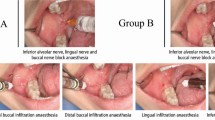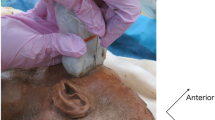Abstract
One of the most commonly used local anesthetic techniques in dentistry is the Fischer’s technique for the inferior alveolar nerve block. Incidentally this technique also suffers the maximum failure rate of approximately 35–45%. We studied a method of inferior alveolar nerve block by injecting a local anesthetic solution into the pterygomandibular space by arching and changing the approach angle of the conventional technique and estimated its efficacy. The needle after the initial insertion is arched and inserted in a manner that it approaches the medial surface of the ramus at an angle almost perpendicular to it. The technique was applied to 100 patients for mandibular molar extraction and the anesthetic effects were assessed. A success rate of 98% was obtained.




Similar content being viewed by others
References
Malamed SF (1997) Techniques of mandibular anesthesia. In: Handbook of local anesthesia, 4th edn. Harcourt Brace, Noida, pp 228–234
Johnson TM, Badovinac R, Shaefer J (2007) Teaching alternatives to the standard inferior alveolar nerve block in dental education: outcomes in clinical practice. J Dent Educ 71(9):1145–1152
Potocnik I, Bajrović F (1999) Failure of inferior alveolar nerve block in endodontics. Dent Traumatol 15(6):247–251
Madan GA, Madan SG, Madan AD (2002) Failure of inferior alveolar nerve block: exploring the alternatives. J Am Dent Assoc 133(7):843–846
Parsons-Smith G, Roberts JM (1970) Facial paralysis after local dental anaesthesia. Br Med J 4(5737):745–746
Rifkind JB (2011) Management of a broken needle in the pterygomandibular space following a vazirani-akinosi block: case report. J Can Dent Assoc 77:b64
Stacy GC (1994) Barbed needle and inexplicable paresthesias and trismus after dental regional anesthesia. Oral Surg Oral Med Oral Pathol 77(6):585–588
Hochman MN, Friedman MJ (2001) An in vitro study of needle force penetration comparing a standard linear insertion to the new bidirectional rotation insertion technique. Quintessence Int 32(10):789–796
Author information
Authors and Affiliations
Corresponding author
Rights and permissions
About this article
Cite this article
Chakranarayan, A., Mukherjee, B. Arched Needle Technique for Inferior Alveolar Mandibular Nerve Block. J. Maxillofac. Oral Surg. 12, 113–116 (2013). https://doi.org/10.1007/s12663-011-0310-1
Received:
Accepted:
Published:
Issue Date:
DOI: https://doi.org/10.1007/s12663-011-0310-1




